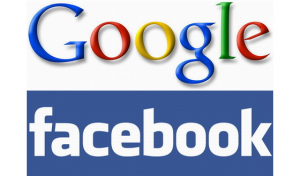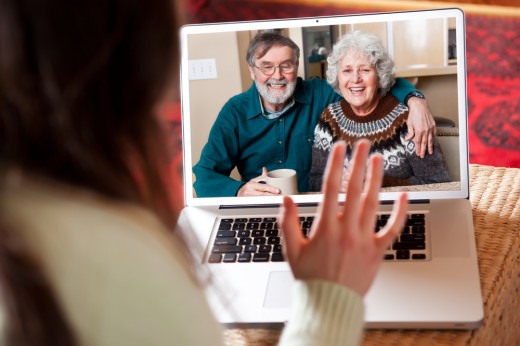
At least once a day, I’m asked by some casually-curious user for my opinion on whether or not Google+ will beat out Facebook. It’s one of those hypothetical questions that makes me roll my eyes and take slow, deep breaths.
As someone who has been following the growth of both networks almost religiously for the past four months now, hearing the same drum beating over and over has begun to wear on my nerves. In fact, I’d wager that the companies at the focus of this question are also tired of being forced to lament over this same debate.
One of the key reasons this social network rivalry is the subject of such intense critique, however, is because the dissection of both platforms is actually incredibly important to the way marketers of the future need to think. With new networks and tools being introduced nearly every day, it is absolutely vital for social media strategists and business developers alike to stay on top of what’s current, what’s trending, and what has the potential to go viral — and all with profitability, bottom lines and ROI in mind.
Luckily for them, my encyclopedic back-knowledge (#humblebrag) and ongoing obsession with social media has left me with several important points to make in favor of Google+, the new social hub that is pioneering the way through unfamiliar territory for typical social campaign strategies. Let’s dive in.
What do the actual companies think of one another?
 While analysts, press and other interested third party critics have definitely had their chance to preach both their eulogies and praise for each of the networks, the two competing platforms themselves also have more than a bit to say on the subject. For example, it’s nearly impossible to get through any current-day interview with Zuckerberg or some Google-elite without hearing that same question, “Will Google+ ever overtake Facebook?”
While analysts, press and other interested third party critics have definitely had their chance to preach both their eulogies and praise for each of the networks, the two competing platforms themselves also have more than a bit to say on the subject. For example, it’s nearly impossible to get through any current-day interview with Zuckerberg or some Google-elite without hearing that same question, “Will Google+ ever overtake Facebook?”
Facebook COO, Sheryl Sandberg — formerly Vice President of Global Online Sales and Operations at Google — has been quoted saying, “Google is all about algorithms and machine learning” while “Facebook, on the other hand, begins with and focuses on the individual.”
On this same topic, high profile Facebook CEO, Mark Zuckerberg, notes that the determining contrast between Facebook and Google is this: Facebook is laser-focused on the social aspect of its product, while acquiring and partnering up with third party companies in order to build out the rest of its features (ie. video, music, games etc). On the other hand, Zuckerberg adds that Google appears to be trying to do everything at once for Google+, taking the company off the social path on which Facebook has derived most of its success.
Of course, these observations only come from one side of the story and, in order to get the complete picture, we should look at what Google has said about the competition between the two platforms. In response to Zuckerberg’s statements, Google’s VP of Product, Bradley Horowitz, joked, “We’re delighted to be underestimated.”
 Christian Oestlian, Lead in Social Advertising with Google, recently gave a talk at AdTech New York where he said,
Christian Oestlian, Lead in Social Advertising with Google, recently gave a talk at AdTech New York where he said,
“We don’t think of Google+ in terms of what other people are doing today. Certainly, there’s that feature-race, where we want to make sure we have enough products featured in and around Google+ to make it interesting. But for us, even if there was no social service out there today, we would want to implement this strategy.
[Google+] is about transforming your relationship with Google. The number of people going to Google on a daily basis rivals virtually all other properties out there. If we can take that experience more social, interesting and personalized, that’s something we want to do no matter who else is engaged in the same space.”
The two competing networks clearly do have one another in mind, though each appears to be approaching their strategy in a different way. Fortunately, this heavy competition and constant feature-building can only mean good things for brands and companies looking to take a more social approach towards marketing and engagement with consumers.
To properly explain the benefits of social marketing through both networks would be a chore in and of itself, so again, this article is for those of you looking for an excuse to use Google+ more. During his talk, Oestlien broke down exactly why and how brands and companies should be using Google+, illustrating his ideas through various points, all of which I’ve listed and explained for you below.
Google+ Pages are the official search profiles for brands
 If your company or brand doesn’t have an official Googe+ Page yet, now is the time to snatch one up. With Google+, the little +1 button will soon be absolutely everywhere — in display campaigns, various advertisements, on your website and even next to search results. The +1 button is the fastest growing social recommendation widget in history and is on over 1 million websites, receiving well over 5 billion impressions a day. But why does this matter in terms of Google+ Pages and your brand?
If your company or brand doesn’t have an official Googe+ Page yet, now is the time to snatch one up. With Google+, the little +1 button will soon be absolutely everywhere — in display campaigns, various advertisements, on your website and even next to search results. The +1 button is the fastest growing social recommendation widget in history and is on over 1 million websites, receiving well over 5 billion impressions a day. But why does this matter in terms of Google+ Pages and your brand?
The +1 is Google’s way of tracking who all is recommending and interacting with your brand across the web. Soon, all the +1s around your brand will be connected directly to your official Google+ Page, anchored to your identity and allowing you to analyze data related to those +1 clicks. With more +1 clicks in aggregate, Google will be able to take those recommendations and analytics then put your company in places that actually matter. In this manner, Google+ will extend your brand and put it in front of users across the globe.
Soon, searching with the plus symbol in front of a brand name in Google Search will automatically redirect customers and users straight to that brand’s official Google+ Page, part of the Direct Connect feature. Oestlien adds:
“Think about the power of that. Typing in ‘+YouTube’ goes straight to the Google+ YouTube Page and automatically adds YouTube to your circles on Google+ for easy following. An on-going relationship gets established through one Google Search. This isn’t about Google — it’s about Plus and your brand, putting you at the center of everything on Google.”
The ability to drive customers directly to your brand’s online identity with one simple search through Google is invaluable. A shortcut like that will immediately open doors between your brand and potential longterm consumers, allowing you to engage them the moment they’ve added your brand to their Google+ Circle and pull them deeper into that relationship.
Businesses don’t make customers happy, people do
 According to Oestlien, surveys reveal that 90% of people rely on personal recommendations from friends before they make unfamiliar decisions. These recommendations can lead to purchase decisions, product decisions and even which restaurants to eat at or hotels to stay in. Couple that with the 84% of people doing actual online research before they make any final decision and you have a powerful driving factor behind what makes potential consumers tick.
According to Oestlien, surveys reveal that 90% of people rely on personal recommendations from friends before they make unfamiliar decisions. These recommendations can lead to purchase decisions, product decisions and even which restaurants to eat at or hotels to stay in. Couple that with the 84% of people doing actual online research before they make any final decision and you have a powerful driving factor behind what makes potential consumers tick.
Google is uniting the idea of recommendations and research through Google+. Or in Oestlien’s words, it is “marrying the power of personal recommendations with the immediacy and power of recommendation on Google search.” That +1 button lets your brand’s fans and users recommend you no matter where they might see you on the Internet — +1 will surface recommendations when and where they matter the most.
When a potential consumer is searching on Google for a great new crepe place in San Francisco, for example, that consumer might see that his or her friend has clicked the +1 button next to Queen Malika Cafe in Castro.
Being able to immediately see that a friend has recommended that restaurant right from Google’s search feature could make a huge impact on user decisions. This increases performance for marketers who are seeing a significant increase in click through rates. Not only does that little +1 button clicked by a friend drive more traffic to sites, it also drives actual feet to the physical stores. Profitability abound!
Google+ drives conversations, not just comments.
About 95% of social posts online go unanswered and unresponded to. This is a huge number, yes, but for the 5% that actually do respond, their impact on the marketing and campaign of any brand is enormous. It is the reactions from that 5% that everyone else will see, not the silent or lurking 95% who aren’t participating.
The real question is, why is that 5% even bothering to reach out, and how can brands capitalize on that willingness to engage? The simple answer is that people want to feel important, want to be interacted with, and want to feel responded to. Do it! Conveniently, Google+ is providing the means for which this response and engagement between brands and consumers can be completed.
Let’s first look at an example. Oestlien referenced the Old Spice guy in his talk, explaining that this rugged brand ambassador responded to each comment he received through social media by creating a personalized and funny video. This light-hearted approach to customer communication resulted in 1.5 billion impressions and a 25% increase in sales. “People’s expectations are so low,” Oestlien notes. “They don’t expect a response, so when they do get one, they love it.”
To make reaching out to your brand’s audience easier and more personal at the same time, Google+ provides the Hangout feature, a way for brands to have a face-to-face conversation with their actual audience through Google+’s group video chatting functionality. Macy’s, for example, did a Hangout where they brought in fashion bloggers to give fashion advice to its followers on Google+. In another instance, Disney also did a Hangout using the Muppets to promote their own page.
Enabling key users to interact with the brands they know and love by having a real conversation with the people behind them will promote that positive public reputation your brand needs. What better way to engage your following than through your very own SEO optimized page on Google+?
Google+ lets you better manage and target your audience
The great thing about Google+ Pages is although they act as the official identity of your brand in Google+, they also work just like normal Google+ profiles. By this, I mean that you can easily add your followers to varying circles in order to better target which content they will see, just like normal users can. Some brands have actually taken to literally asking their followers which circles they want to be added to, then sorting their circles accordingly.
 Google sees two to three times more posts to circles than general sharing to everyone on the platform. Not everyone wants to see the same thing, after all, and likewise, you might not want to share absolutely everything with the world. This more intuitive circles model will help your brand focus on delivering people the content they actually want to see. For example, a startup might only want to share Press Releases with actual journalists and reporters following its Google+ Page, and so will share with that circle alone, ensuring that the content reaches the appropriate users.
Google sees two to three times more posts to circles than general sharing to everyone on the platform. Not everyone wants to see the same thing, after all, and likewise, you might not want to share absolutely everything with the world. This more intuitive circles model will help your brand focus on delivering people the content they actually want to see. For example, a startup might only want to share Press Releases with actual journalists and reporters following its Google+ Page, and so will share with that circle alone, ensuring that the content reaches the appropriate users.
Then there’s Ripples on Google+, analytics that let you dig deep into the data of your Page down to a microscopic level. In this way, you’ll be able to find out who’s saying what about your brand after they’ve shared one of your posts, as well as find out more details about each relevant conversation.
For brands not yet using Google+, Oestlien recommends simply signing up to the service to create a brand page that can be integrated into an existing social strategy.
“Social marketing, it’s not about doing something completely new. It’s about improving everything you already do to make that experience more social, engaging, richer and more rewarding for your user and audience by incorporating sharing and recommendations and relationships that already exist in the real world to the Internet. Transform your experience with Google.
Behind these Pages, there are people. As marketers, we need to transform the way we think — bring these people to the front, give them more power to engage directly with these audiences through Google+ Hangouts, through the Pages themselves, etc. [Through Google+], you can actually engage in a much more meaningful way.”
Again, this is why social media marketers should not be ignoring the platform. Google+ is the search identity for your brand. Your Google+ Page is what will pop up when your audience searches for you, is where every +1 on your content across the Internet will redirect towards, and is where you’ll be able to optimize your search results directly from the social hub of the search engine itself. Google+ is Google.
Will Google+ beat out Facebook?
 Touching on the question of whether or not I think Google+ will beat out Facebook? Well. Sure I do — but in a completely different game. Google+ is the future of search branding and marketing, encouraging the brand-to-user and user-to-brand experience through more intimate and personal engagement. In this area, yes, I believe it will succeed.
Touching on the question of whether or not I think Google+ will beat out Facebook? Well. Sure I do — but in a completely different game. Google+ is the future of search branding and marketing, encouraging the brand-to-user and user-to-brand experience through more intimate and personal engagement. In this area, yes, I believe it will succeed.
The only thing that currently appears to be in the way is the rate at which Google+ is being adopted — most users are rather comfortable with Facebook and Twitter (Facebook has 850 million users, Twitter has 400 million sign ups, and Google+ is currently wavering over 40 million). Fortunately, it’s still early days and the platform is only going to get better as it continues to collect usage data over time.
If you’re not on Google+ yet, you should be. But if you’re content with missing out on prime social and search-driven real estate, then hey, maybe Google+ isn’t for you?
Want more? Check out Social Media ROI: It’s not about immediate results, and Google+’s secret weapon against Twitter and Facebook.
Get the TNW newsletter
Get the most important tech news in your inbox each week.






